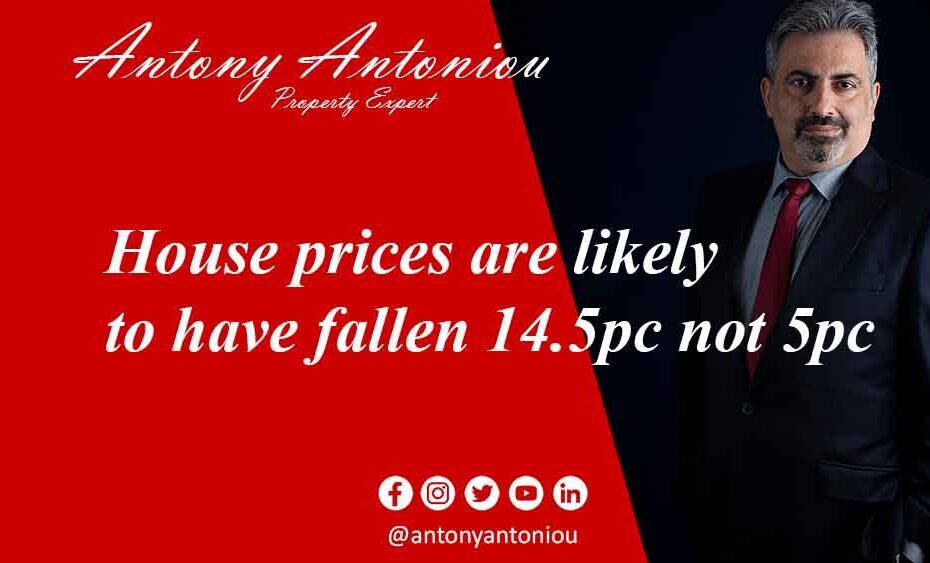House prices are likely to have fallen 14.5pc not 5pc
The Hidden Truth Behind the 14.5% Drop in House Prices
In recent times, the property market has been an unpredictable rollercoaster ride. Many homeowners and potential buyers have been keeping a close eye on house prices, and some alarming statistics have started to emerge. While it may seem like property values have only fallen by 5%, the truth is far more complex once we factor in inflation. In reality, prices may have dropped by as much as 14.5%, according to Capital Economics.
Understanding the Real Numbers
At first glance, a 5% drop in house prices might not raise too many eyebrows, but this figure can be deceptive. When inflation is taken into account, it significantly alters the picture. Capital Economics’ research consultancy suggests that property prices have plummeted by a substantial 14.5%, and they even forecast a peak-to-trough fall of 20.8% in “real terms.”
Neal Hudson, from BuiltPlace, points out that high inflation and rising wages have played a significant role in this price correction. Surprisingly, high wages, a key contributor to inflation, have acted as a buffer, preventing house prices from falling significantly in nominal terms.
Rising interest rates, which lead to higher mortgage rates, typically push down house prices by limiting borrowing capacity. However, record pay growth over the past year has empowered individuals, giving them greater buying power and contributing to the persistence of high inflation—a phenomenon known as a “wage-price spiral.”
The Slow Unraveling of House Price Falls
Neal Hudson adds that house price falls always take a considerable amount of time to manifest fully. To put this into perspective, during the 2007 house price downturn, property values fell by 18.3% in real terms and 5.1% in nominal terms in the first year. Eventually, the total peak-to-trough fall amounted to 22.6% in real terms and 19.4% in nominal terms.
Richard Donnell, research director at property website Zoopla, anticipates that we may experience similar-sized real house price falls in the coming years, reminiscent of the last downturn. He attributes this to the expectation of consistently high interest rates, which will inevitably drag down house prices.
A Comparison with the 1970s
Interestingly, Neal Hudson suggests that the current house price correction could resemble the two downturns experienced by Britain in the 1970s. Back then, nominal prices did not fall due to even higher inflation, but real prices did experience a significant drop, leading to economic consequences in the housing market. Today, we’re seeing a combination of both nominal and substantial real price corrections.
Challenges in Interpreting House Price Data
House price indices used to calculate these falls have their limitations, often painting a rosier picture than what’s happening on the ground. For instance:
1. Nationwide and Halifax produce monthly indices on prices paid when mortgages are taken out, but these are limited to their customer bases.
2. Rightmove’s house price index reflects asking prices, which can be misleading, as some properties are excessively priced, giving buyers a false sense of a great deal.
3. Asking prices show sellers’ perceptions of property value rather than actual sale prices, and they’ve only dropped by 0.4% in the last year.
4. Nationwide’s index is considered less volatile and serves as a leading indicator, according to experts.
The Office for National Statistics (ONS) provides a more comprehensive dataset for the entire residential market. However, it lags behind mortgage lenders’ indices, as it tracks prices when sales are completed, which can take a while.
The Impact of Cash Buyers
Cash buyers, who aren’t included in Nationwide or Halifax indices, are enjoying larger discounts. Many sellers fear chain breakdowns as mortgage rates rise, making some buyers unable to borrow as much as they initially planned.
Jonathan Hopper, of buying agents Garrington Property Finders, notes that cash buyers expect significant discounts, given their cash offers and the certainty they bring to sellers.
Hidden Discounts in New Builds
New builds are also being discounted in ways that don’t show up in headline house price figures. Developers may not reduce the sale price but offer financial incentives like contributions toward the deposit or mortgage repayments.
Moreover, when one new build in a development decreases in price, it affects the valuation of others. Surveyors use the price set by one new build as a benchmark for the rest, influencing the overall market.
In conclusion, while the official numbers may suggest a relatively minor 5% dip in house prices, the reality is more complex. When inflation and real terms are considered, the fall could be as significant as 14.5%. This intricate interplay of factors, from high wages and inflation to rising interest rates and cash buyers, creates a housing market in constant flux. Understanding the hidden dynamics behind these numbers is crucial for homeowners and buyers navigating today’s property market.

